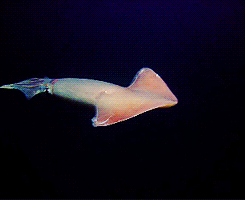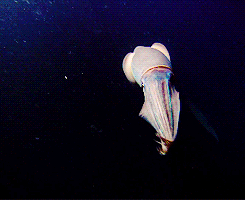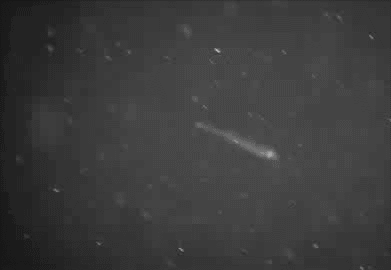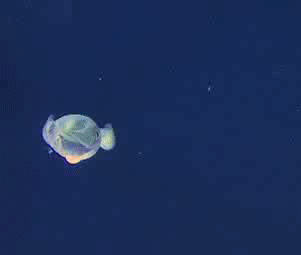
HUMBOLDT SQUID 2
(external videos)
Click on the picture for other websites, video's, and pictures.
Humboldt squid (aka Jumbo Squid) are known to cannibalize each other and are especially likely to eat a squid that has been injured or hooked on fishing lines. They use sharp, barbed tentacles to cut apart their prey and then drag it to their mouth where a baseball-sized beak shreds it into edible pieces.
These squid are large enough to be a potential danger to human divers.
When threatened, squid will attack human divers and continue to put up a fight even after they've been caught, blasting their captors with ink and propelling water out of their funnel.
Like other cephalopods, jumbo squid can alter their coloration to match their environment, changing from white to dark red in an instant.
Humboldt Squid have been given the nickname diablos rojos by Mexican fisherman because of their aggressive reputation and ability to change colors.
Humboldt squid are social animals, sometimes swimming in school of up to 1,200 individuals.
Some squid species (including the Humboldt) can use their funnel to propel themselves out of the water to escape from predators. Their small fins allow them to glide over the water’s surface and “fly” through the air.
Humboldt Squid only live about one year (though larger individuals can live up to 2 years).
Ocean Footage
GIANT HUMBOLDT SQUID ON HD
The giant Humboldt Squid is a legendary denizen of the deep -- elusive, fierce, and beautiful -- and notoriously difficult to film. The Humboldt Squid inhabits depth of 200 to 660 meters, and is an aggressive predator that can reach over 2 meters in length, with exceptional underwater vision, powerful arms and tentacles, and a deadly razor-sharp beak.
National Geographic
Ocean Soul: Night Swimming with Sea Monsters
National Geographic photographer Brian Skerry describes one of his scariest adventures -- swimming at night with hundreds of gigantic Humboldt squid. With his new book from National Geographic, Ocean Soul, Brian showcases his stunning photography and describes his adventurous life in a gripping portrait of the ocean.
Captive Humboldt squid rarely live more than a few days. This makes it especially difficult for researchers to observe and collect data.
Traditionally, Humboldt squid live in the eastern Pacific Ocean, ranging from Tierra del Fuego north to California, but they have recently been spotted as far north as Sitka, Alaska, creating concerns about ecological problems that could be caused by their northward migration.
Lanternfish supply a main food source for Humboldt Squid, and fisherman have taken advantage of this by using lights as fishing lures.
When threatened, Humboldt Squid shoot out ink to confuse or temporarily blind would-be predators.
Female squid produce an egg mass during reproduction that contains an estimated 0.6-2.0 million eggs. Studies suggest that each female can produce 3-20 of these masses
Jumbo squid perform a daily vertical migration, swimming deep during the daytime and moving closer to the water’s surface at night.
National geographic
Oceans: Monterey Bay
Monterey Bay boasts an undersea canyon that is deeper than the Grand Canyon. This rich environment is home to krill, Humboldt squid, mola mola, and a plethora of tiny animals that thrive in giant kelp forests. Narrated by National Geographic Explorer-in-Residence Sylvia Earle.
Video: Humboldt Squid Makes Contact
A Humboldt squid rockets up out of the darkness, meeting Bob Cranston in the middle of a cloud of krill. Agressive at first, the squid grabs hold of Bob’s light. Then, a more peaceful form of curiosity takes over.
















